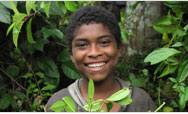Food Security and the Global Water Crisis
The ability to feed the world’s growing population will be severely challenged in coming decades by competition over increasingly limited water resources. Since the advent of the “green revolution” more than 30 years ago, the world has by and large managed to keep food production in pace with population growth. That situation is changing, however, with growth in world grain production markedly slowed since 1990. While reasons for the decline are complex, concern is mounting over the central role that irrigation plays in global food security, and the realization that achieving increased supply of irrigation water may become exceedingly difficult. On a global scale, irrigated agriculture accounts for less than 20% of the total cropland area, yields 40% of agricultural output, and consumes nearly 70% of total developed water supply.
Water Scarcity Threatens Global Irrigated Crop Production
Water shortages threaten to reduce global food supply by more than 10% in the next 25 years. Aquifer depletion, salinization of soils, and the reallocation of agricultural water to other sectors and users will combine to limit irrigated crop production. China’s projected grain shortfall alone (conservatively estimated at 175 million tons per year by 2025) would result in steep price increases and disruption of world grain markets, the brunt of which would be felt by the world’s poorest nations.
Exactly how much water will be needed to meet projected food demand is not well understood, but studies suggest that at least 20% more irrigation water will be needed by 2025. Falling investments in new dams and irrigation, combined with unsustainable aquifer depletion rates, dim the prospects for substantially increased irrigation even if it were desirable. Water demand competition is also growing among other stakeholders, including those of industry, expanding urban centers, and aquatic ecosystems. Assuming for a moment, however, that the 2025 global crop water requirement is met entirely by irrigation, an additional 2,050 cubic kilometers would be needed yearly—equivalent to the annual flow of twenty-four Nile Rivers or Colorado Rivers.
Water Scarcity Threatens Global Animal-protein Production
The animal protein component of the global food supply also has significant linkages with water resources management. The world relies heavily on oceans and rangelands for animal protein, but since 1990 both of these systems have been approaching their productive limits. Oceanic systems yield 80 million tons of seafood per year, a particularly important protein source in developing countries that accounts for one-fifth of animal protein consumed worldwide. Little or no growth can be expected in oceanic fish catch, however, as all 17 of the world’s major fishing areas have either reached or exceeded their natural limits. Beef production has also peaked, due at least in part to declining soil fertility of more than 20% of the world’s pasture and rangeland. Meanwhile, aquaculture has become the fastest growing sector of the world food economy, and is now poised to overtake cattle ranching as a food source by 2010.
Water quantity and quality are integral to the health and productivity of ocean, freshwater, and rangeland systems. The timing and volume of freshwater inflow is exponentially correlated with biomass production in estuarine environments, where 60%-75% of all commercially important oceanic species spend part of their lifecycles. The world’s 1.3 billion cattle are likewise a significant component of the water-for-food budget, requiring 7 kg of grain for every 1 kg of live weight. (As a rule of thumb, 1,000 tons of water is required to produce 1 ton of grain.) In contrast, fish require on average 2 kilograms of grain to add 1 kilogram of live weight, and are therefore more “water efficient” as an animal protein source. Aquaculture presents both costs and benefits, producing “water efficient” fish while exacting a heavy toll on habitat and water quality, and increasing evaporative losses from freshwater ponds. Clearly, these tradeoffs have important implications for evolving food and water management policy.
The “Water-Use Efficiency” Approach in Food Production
While calculating water needs for global food security is a difficult and inexact science, we are beginning to understand just how limited options are for expanding current food production. A major determinant is “water-use efficiency,” which in turn depends on several factors, including climate, evaporation rates, soil fertility, choice of crops, and the genetic potential of those crops. Assuming that we can successfully optimize each of those variables, we must still contend with the water supply issue—both quantity and quality—and the efficiency by which that water becomes subsurface soil moisture for crop production. Managers must keep in mind the fact that due mainly to evaporative dissipation and subsoil infiltration along transport pathways, less than half the water removed from rivers and aquifers for irrigation actually benefits a crop.
Additional Tools in Water Resources Management in Food Production
Achieving global food security will require both effective water resources management and reform of food policy. Many actions needed are straightforward and should be instituted wherever feasible without delay. In this category, perhaps the most needed are actions to ensure that the best rain-fed agricultural lands remain in production. Improvements in soil and water conservation practices should likewise be immediately implemented, including small-scale water harvesting, terracing, and other means to channel and store water to increase soil moisture content. The ultimate goal is to produce more “crop per drop” and more sustainable livelihoods per unit of water, to ensure that water shortages do not turn into food shortages for the world’s poor.
Back to Top ^
|


